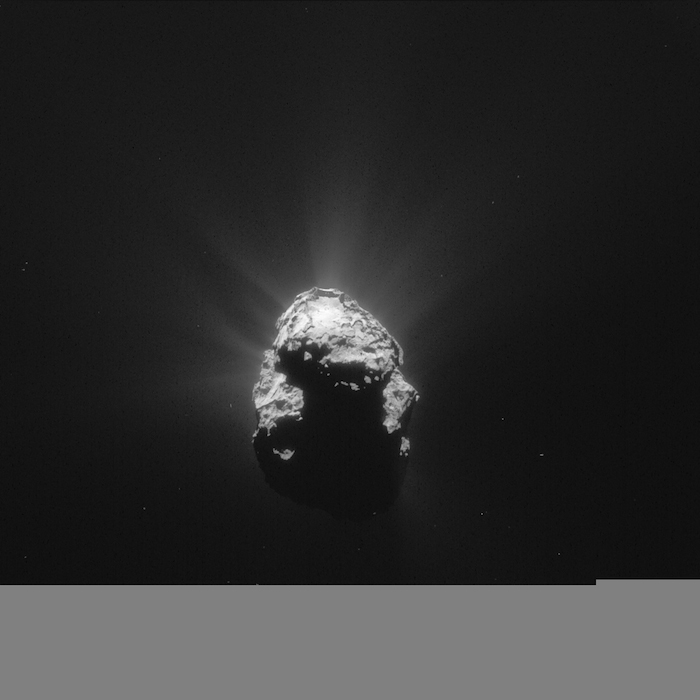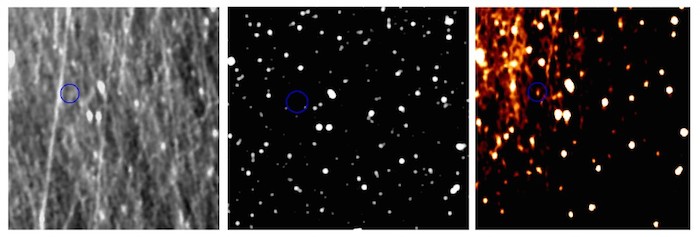.
10.07.2015
NEW COMMUNICATION WITH PHILAE – COMMANDS EXECUTED SUCCESSFULLY
This report is provided by the German Aerospace Center, DLR.
The Philae lander communicated with the Rosetta orbiter again between 19:45 and 20:07 CEST on 9 July 2015 and transmitted measurement data from the COmet Nucleus Sounding Experiment by Radiowave Transmission (CONSERT) instrument. Although the connection failed repeatedly after that, it remained completely stable for those 12 minutes. “This sign of life from Philae proves to us that at least one of the lander’s communication units remains operational and receives our commands,” said Koen Geurts, a member of the lander control team at DLR Cologne.
The mood had been mixed over the last few days; Philae had not communicated with the team in the DLR Lander Control Center (LCC) since 24 June 2015. After an initial test command to turn on the power to CONSERT on 5 July 2015, the lander did not respond. Philae’s team began to wonder if the lander had survived on Comet 67P/Churyumov-Gerasimenko.
“We never gave up on Philae and remained optimistic,” said Geurts. There was great excitement when Philae ‘reported in’ on 13 June 2015 after seven months of hibernation and sent data about its health. The lander was ready to perform its tasks, 300 million kilometres away from Earth.
However, Philae has to communicate with the ground stations through Rosetta, which acts as a radio relay. Restrictions on the orbiter’s approach to and orbit around the comet have not permitted regular communication with the lander. The data sent on 24 June did not suggest that the lander had experienced technical difficulties. Now, Philae’s internal temperature of zero degrees Celsius gives the team hope that the lander can charge its batteries; this would make scientific work possible regardless of the ‘time of day’ on the comet.
The received data is currently being evaluated. “We can already see that the CONSERT instrument was successfully activated by the command we sent on 9 July,” explained Geurts. Even now, Philae is causing the team some puzzlement: “We do not yet have an explanation for why the lander has communicated now, but not over the past few days.”
The trajectory of the orbiter, for example, has not changed over the last three weeks. However, one thing is certain; Philae has survived the harsh conditions on the comet and is responding to commands from the LCC team. “This is extremely good news for us,” said Geurts.
Watch the latest video update from the LCC, here.
Rosetta is an ESA mission with contributions from its Member States and NASA. Rosetta's Philae lander is contributed by a consortium led by DLR, MPS, CNES and ASI.
.
COMETWATCH 25 JUNE
Today’s CometWatch entry presents an image taken on 25 June from a distance of 168 km from the comet centre. The image scale is 14.3 m/pixel and the image measures 14.6 km across. The image has been processed to highlight the details of the comet’s activity.
.

NAVCAM image of Comet 67P/C-G taken on 25 June 2015, 168 km from the comet centre. Credits: ESA/Rosetta/NAVCAM – CC BY-SA IGO 3.0
In this orientation the unmistakable outline of the Hatmehit depression on the comet’s small lobe can be seen towards the ‘top’ of the scene. In the foreground, the ‘Nut’ depression is visible while Serqet is cast in dappled shadow.
Much of the large lobe is obscured by shadow, but a glimpse of Seth can just be seen on the bottom left with Babi in the distance.
On the right hand side a sharp transition between Seth and Anubis is seen, with a small patch of Atum just catching the sunlight at bottom right. The section in the background comprises areas previously in shadow and as such the boundaries are less well defined.
-
14.07.2015
.
HELLO, PLUTO!
Images obtained by OSIRIS, Rosetta’s scientific imaging system, show dwarf planet Pluto shortly before the flyby of NASA's New Horizons.
.

After careful image processing dwarf planet Pluto shows itself in these images obtained by Rosetta’s scientific imaging system OSIRIS on 12 July 2015. Left: The unprocessed image is obscured by dust grains in Comet 67P/C-G’s coma. Middle: Pluto’s background of stars as seen from Rosetta. Right: The processed image shows Pluto as a bright spot within the blue circle.
Credits: ESA/Rosetta/MPS for OSIRIS Team MPS/UPD/LAM/IAA/SSO/INTA/UPM/DASP/IDA
On Sunday 12 July 2015, OSIRIS, the scientific imaging system on board ESA’s spacecraft Rosetta, took a glance away from Comet 67P/Churyumov-Gerasimenko to the edge of our Solar System, towards Pluto.
Over five billion kilometres away, an exposure time of more than three hours, and sophisticated image processing, was necessary to detect Pluto in the images. Twenty images, each exposed for ten minutes, had to be stacked and carefully processed to reveal the tiny world. Pluto is thus the most distant body within the Solar System that Rosetta has ever looked at.
NASA’s space probe New Horizons made its historic flyby of this distant world today, passing within about 12500 km.
Being able to discern the 2370 km-wide body in OSIRIS images comes close to a small miracle, say the imaging team. “After all, OSIRIS is not a telescope, but a camera system designed to study Rosetta’s comet from up close," says OSIRIS Principal Investigator Holger Sierks from the Max Planck Institute for Solar System Research (MPS) in Germany.
"Apart from the huge distance there was another difficulty," says OSIRIS team member Dennis Bodewits from the University of Maryland who worked on the images. “Comet 67P and Rosetta are by now surrounded by a dense atmosphere of gas and dust. It’s like watching Pluto through a blizzard.”
The observation is particularly symbolic given that both Pluto and Comet 67P/C-G hail from the Kuiper Belt in the Outer Solar System. Comet 67P/C-G is now a Jupiter Family Comet and is currently in the inner Solar System, a month away from perihelion, the closest point to the Sun along its orbit. Pluto is a dwarf planet residing in the Kuiper Belt, and has an elliptical orbit around the Sun.
Rosetta has imaged a number of Solar System objects on en route to Comet 67P/C-G: Earth, Mars and the asteroids Steins and Lutetia during flybys, along with the more distant comet 9P/Tempel 1, asteroid P/2010 A2, and Saturn. “As in the case of Pluto, in comparison to observations from Earth such images often offer a unique and instructive viewing perspective,” says Sierks.
The Rosetta mission team sends its best wishes to the New Horizons team on today’s historic flyby!
About Rosetta
Rosetta is an ESA mission with contributions from its member states and NASA. Rosetta's Philae lander is provided by a consortium led by DLR, MPS, CNES and ASI.
About OSIRIS
The scientific imaging system OSIRIS was built by a consortium led by the Max Planck Institute for Solar System Research (Germany) in collaboration with CISAS, University of Padova (Italy), the Laboratoire d'Astrophysique de Marseille (France), the Instituto de Astrofísica de Andalucia, CSIC (Spain), the Scientific Support Office of the European Space Agency (The Netherlands), the Instituto Nacional de Técnica Aeroespacial (Spain), the Universidad Politéchnica de Madrid (Spain), the Department of Physics and Astronomy of Uppsala University (Sweden), and the Institute of Computer and Network Engineering of the TU Braunschweig (Germany). OSIRIS was financially supported by the national funding agencies of Germany (DLR), France (CNES), Italy (ASI), Spain (MEC), and Sweden (SNSB) and the ESA Technical Directorate.
.
15.07.2015
.

CLAUDIA ALEXANDER (1959–2015)
-
It is with great sadness that we share the news of Dr Claudia Alexander’s passing on 11 July 2015.
Claudia worked for NASA at JPL. She was an eminent planetary scientist and was deeply involved with the Rosetta Mission as US Rosetta project scientist. She was passionate about outreach, including engaging amateur astronomers through the ground-based observing campaign of Rosetta’s target comet, 67P/Churyumov–Gerasimenko. Claudia was also very well known for her role in NASA’s Galileo and Cassini projects.
Here, some of her ESA colleagues pay tribute:
“We have lost a great colleague and friend who will live on within us and the missions to the stars she made possible.”
Matt Taylor, ESA’s Rosetta project scientist
“Although I did not know Claudia very well, I quickly noticed her strong enthusiasm for the Rosetta mission. The science of this mission has lost a major contributor and we will all miss her.”
Patrick Martin, ESA’s Rosetta mission manager
“When I was asked to join Rosetta and address some challenges in June 2013, Claudia, who was well aware of the pending items, supported me in the most professional way. She was involved in Rosetta for a very long time and always had the best interest of the overall project at heart. Although I am currently no longer involved in Rosetta, I know she will be dearly missed by the team for her heartfelt drive to further cometary science. The impact of her loss to planetary science and us as direct colleagues is of little significance compared to the impact this must have on her loved ones.”
Fred Jansen, former Rosetta mission manager
“I was deeply shocked when I learned that Claudia had passed away. She was for many years my counterpart at NASA as mission manager and project scientist for NASA’s contribution to Rosetta. Claudia was always full of energy and optimism and supported us to make the mission the success it has become. The US co-meetings, which were open to all of us, and the sessions she organised at AGU, will always be remembered as inspiring opportunities to discuss the latest developments in cometary science openly and sometimes controversially. She had a great personality and it was always a pleasure to discuss her new outreach projects and the science books she wrote for children, topics that were close to her heart. I will miss her and the Rosetta teams will miss her, and she will always be remembered for her outstanding contribution to Rosetta.”
Gerhard Schwehm, former Rosetta project scientist and mission manager
Quelle: ESA
4026 Views
